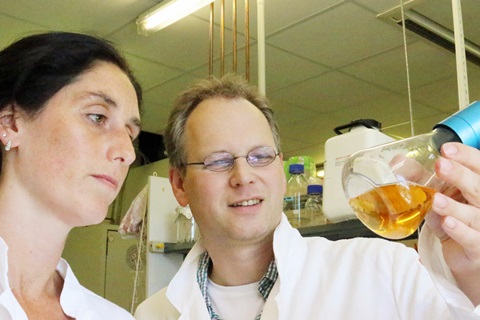 Since the advent of modern biotechnology, we have experienced a tremendous development, driven and inspired by demand, competition, and the quest for novel, exclusive and sustainable products from renewable resources. Nature itself delivers a diversity of organisms, enzymes, pathways, and metabolic reactions to convert simple carbon sources to desired molecules. Application ranges from bio-based chemicals, new materials, and improved biofuels to products for health and nutrition.
Since the advent of modern biotechnology, we have experienced a tremendous development, driven and inspired by demand, competition, and the quest for novel, exclusive and sustainable products from renewable resources. Nature itself delivers a diversity of organisms, enzymes, pathways, and metabolic reactions to convert simple carbon sources to desired molecules. Application ranges from bio-based chemicals, new materials, and improved biofuels to products for health and nutrition.
 Harnessing the biological complexity and variability was enabled by combining recombinant DNA technology with systems and synthetic metabolic engineering. Here, a fundamental understanding of cellular physiology and its regulation forms the knowledge base. So-called “omics” platform technologies provide what is needed: comprehensive and quantitative data at the various layers of genes, transcripts, proteins, metabolites and pathway fluxes, respectively, which disclose the best strategy for the genetic engineers, how to change the organism. The art at this point for beneficial cellular engineering is to extract truly relevant information from the large and complex data sets, often generated from systems biology experiments. Especially metabolic modeling combined with statistical evaluation helped to address this multi-target challenge and to provide biologically meaningful and significant correlations and conclusions.
Harnessing the biological complexity and variability was enabled by combining recombinant DNA technology with systems and synthetic metabolic engineering. Here, a fundamental understanding of cellular physiology and its regulation forms the knowledge base. So-called “omics” platform technologies provide what is needed: comprehensive and quantitative data at the various layers of genes, transcripts, proteins, metabolites and pathway fluxes, respectively, which disclose the best strategy for the genetic engineers, how to change the organism. The art at this point for beneficial cellular engineering is to extract truly relevant information from the large and complex data sets, often generated from systems biology experiments. Especially metabolic modeling combined with statistical evaluation helped to address this multi-target challenge and to provide biologically meaningful and significant correlations and conclusions.
Meanwhile, targeted engineering is hardly dispensable for modern strain development, and has been substantially used to optimize the major industrial working horses Escherichia coli, Saccharomyces cerevisiae and Corynebacterium glutamicum. For the industrial feed amino acid l-lysine, knowledge-based design and targeted genetic re-engineering of C. glutamicum even pushed the rationally created hyper-producer beyond the performance of classical producers. Moreover, the obtainable product portfolio has been substantially extended towards other amino acids (e.g. valine, threonine, tryptophan), vitamins (e.g. riboflavin, pantothenate), and natural compounds (e.g ectoine, carotenoids, terpenoids, (deoxy)-violacein) serving as valuable food and feed additives, therapeutics or cosmetic ingredients. Beyond the health and nutrition sector, also novel application fields have been made accessible including the bio-plastics market. Within only a few years, a completely novel process for advanced bio-based polyamide production, comprising strain design, engineering, process development, downstream and polymerization, was established from the scratch using recombinant C. glutamicum for the production of one of the building blocks: diaminopentane. These examples clearly demonstrate the power and value of systems biotechnology, when breaking new grounds for a smart and sustainable industry that is built on renewable raw materials.

First established and applied for mono-septic microbial cultures, the underlying platform technologies are now more and more used to gain insights into systems and processes with higher complexity such as whole plants and interacting microbial communities. What we learn from this can be transferred into advanced and sustainable strategies for growing crops with higher nutritional value, better land use, and higher emblements through, i.e. specialized fertilizers or better resistance against pest and drought. In addition, such techniques can now be used to elucidate fundamental microbial processes of consortia, building for instance the gut microbiome or being used for complex fermentations. Indeed, only recently this provided new insights into the millennia-old cocoa fermentation and revealed a so far unknown and astonishing interaction and dependency of different bacterial species and of yeast, which is required for aroma and flavour development. Thus, the value of systems biotechnology does not only lie in developing new products but also in an in-depth understanding of traditional and well established processes, which builds the knowledge-base for further optimization. Modern systems biology and biotechnology is now at the point to surpass the previous limited and isolated view on specific aspects of microbes, functional metabolic layers and biochemical pathways by fully integrating global and comprehensive datasets to draw an unbiased picture of functional living systems as a whole. Going one step further, similar approaches will help in designing novel and tailored biorefinery concepts. When – similarly to organisms – all aspects of upstream, fermentation and downstream are considered as a closed-meshed and interacting network, biomass feedstocks and pre-treatment thereof can be specifically designed to optimally serve the fermentation requirements, and producer strains can be optimized towards broader substrate ranges, improved performance, and to better tolerate process settings, that will facilitate downstream processing. Recent innovations in this field are promising to further speed up the heartbeat and outreach of such developments. Indeed, we are now at the border to a new era of biotechnology with comprehensively streamlined processes for generating sustainable value-added products from renewable biomass. Prof. Dr. Christoph Wittmann is head of the Institute of Systems Biotechnology at Saarland University, Germany. His research interests involve metabolic engineering, industrial biotechnology and synthetic biology. At the Science Symposium in Chicago he will give a presentation on metabolic engineering. His blog entry is based on a substantial article he published together with Dr. Judith Becker in Angewandte Chemie (Vol.127, No.11, 3383-3407, 2015).
Additional Links: BASF Creator Space, BASF Science Symposium: Sustainable Food Chain